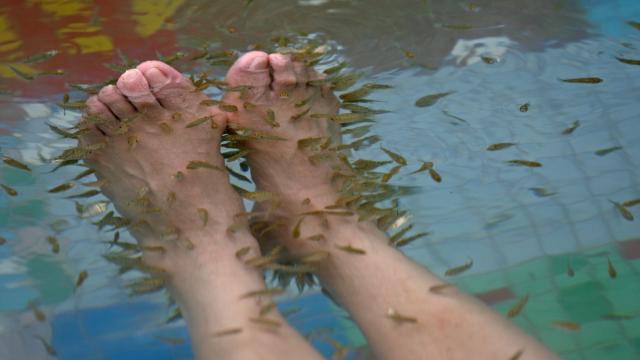An unorthodox beauty treatment meant to rejuvenate the feet turned into a disturbing medical mystery for one young woman. According to a case report published by her doctor in JAMA Dermatology, the woman’s toenails stopped growing and started falling off soon after she received a so-called fish pedicure.
Fish pedicures involve having small fish nibble at your feet while they’re soaked in a tub of warm or room temperature water. The species of fish used – a toothless carp known as Garra rufa – are usually plant eaters, but in a pinch, they will also eat dead human skin.
The fish’s voracious feasting is said to help treat conditions such as psoriasis as well as beautify the skin, lending them the nickname of “Doctor Fish”.
Unfortunately for the unnamed woman in her 20s, her experience was anything but rejuvenating. Following her pedicure, most of her toenails on both feet stopped growing and began to fall off, a condition known as onychomadesis.
Six months into her nail troubles, she visited a dermatologist, who ruled out any known causes of onychomadesis, such as major illness or a side effect of certain medications. The most likely culprit, then, was the fish pedicure.
“While the mechanism of action is not entirely clear, it is likely due to the fish traumatising the nail matrix,” Sheri Lipner, an assistant professor of dermatology at Columbia University’s Weill Cornell Medicine and the woman’s treating doctor, told Gizmodo via email.
The case, as far as Lipner knows, would be the first documented instance of onychomadesis ever caused by fish.
For the sake of protecting her patient’s anonymity, Lipner can’t reveal where the woman got her pedicure. But she notes these treatments are fairly popular outside of the US, such as in China. They hit their peak in popularity in the US around a decade ago, but have since been banned in at least 10 states, including New York, largely because of health concerns.
For one, the fish are often used on more than one person, making the risk of transmitting infections a real possibility. And though proponents of fish pedicures have argued they can properly sanitise the fish and tubs between uses, research has shown that disease-causing bacteria can be readily found in both the tubs and fish used in these spas.
A few case reports have also directly traced foot infections to these treatments.
“I do not recommend fish pedicures for any medical or aesthetic purpose,” Lipner said. “In addition to onychomadesis, there are also serious infections associated with fish pedicures.”
As for the woman, her nails will likely return, but not for a long time. Lipner notes that our toenails only grow 1mm a month on average, while an entire nail can take as long as 18 months to be replaced. “Therefore, we will have to wait quite a while to see the outcome,” she said.
